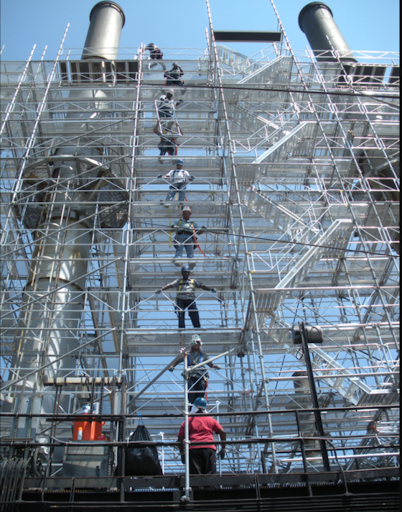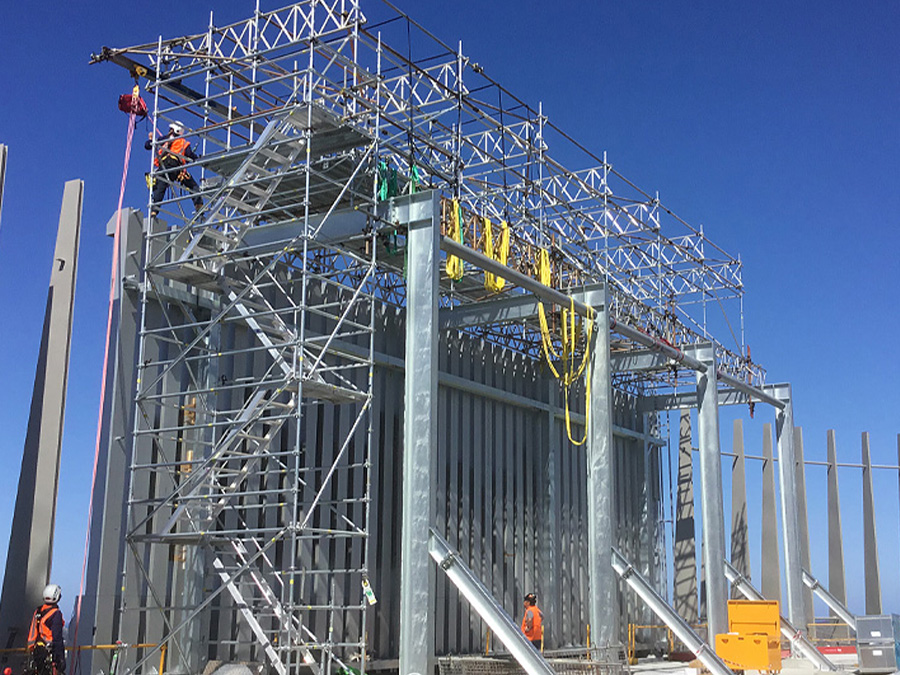Temporary Roof Scaffolding to Ensure Safe Working Conditions During Projects
Checking Out the Various Sorts Of Scaffolding Utilized in Building And Construction Projects
The building and construction industry depends heavily on various types of scaffolding to fulfill specific project demands, each offering distinctive benefits and applications. Conventional frame scaffolding supplies a sturdy structure for general tasks, while suspended scaffolding is vital for work on skyscraper structures.

Typical Frame Scaffolding
Conventional frame scaffolding is among the most commonly made use of approaches in the building and construction market due to its toughness and flexibility. This system includes straight and vertical structures that are assembled to produce a secure system for employees and products. The main elements include vertical articles, straight journals, and diagonal braces, which with each other provide a strong framework that can sustain considerable loads.
Among the essential advantages of conventional framework scaffolding is its versatility to different construction projects, varying from domestic buildings to large industrial frameworks. The modular layout enables very easy assembly and disassembly, making it reliable for both short-term and long-term tasks. Additionally, the system can be tailored in elevation and size, suiting various building designs and website conditions.
Safety and security is vital in scaffolding applications, and conventional frame systems are geared up with guardrails and toe boards to stop falls and guarantee worker defense. Routine assessments and adherence to security regulations are crucial in preserving the honesty of the scaffold (Scaffolding). In general, conventional framework scaffolding remains a basic selection in the construction industry, supplying a reliable system for labor and improving overall project efficiency

Suspended Scaffolding
Put on hold scaffolding offers a special remedy for construction projects that need accessibility to raised surfaces, particularly in situations where standard structure scaffolding might be impractical. This kind of scaffolding is generally suspended from the roofing or upper levels of a framework, making use of a system of ropes, sheaves, and platforms to produce a working room that can be gotten used to various elevations.
Among the main advantages of suspended scaffolding is its versatility. It can be conveniently rearranged or lowered to fit changes in building requirements, making it ideal for tasks such as home window setup, façade job, and upkeep on high-rise structures. Furthermore, the minimal footprint of suspended scaffolding permits for much better use ground room in urban settings, where area is typically minimal.
Safety and security is an important consideration in using put on hold scaffolding. Appropriate rigging and anchoring systems must be utilized to make sure stability and protect against mishaps. Operators has to also be learnt the safe usage of this equipment. Generally, suspended scaffolding offers a effective and reliable service for accessing hard-to-reach locations in different construction circumstances, enhancing both performance and safety and security on site.
System Scaffolding
System scaffolding, frequently considered as a contemporary option in the scaffolding industry, is composed of pre-engineered components that can be swiftly set up and adapted for numerous building and construction projects. Scaffolding. This sort of scaffolding is identified by its modular style, which allows for versatility and performance on job sites, fitting different elevations and structural demands
Typically made from high-strength steel or light weight aluminum, system scaffolding supplies enhanced sturdiness and security. The parts consist of upright posts, horizontal journals, and angled braces, which adjoin safely, guaranteeing a robust framework. The style frequently includes standard installations, streamlining setting up and disassembly procedures, thereby lowering labor time and expenses.

Rolling Scaffolding
Moving scaffolding is a versatile option to traditional set scaffolding, created for movement and ease of use on building read here sites. This sort of scaffolding consists of a platform supported by frames with wheels, enabling workers to easily move it as required. The flexibility feature dramatically enhances performance, as it lessens downtime related to putting together and disassembling dealt with scaffolding.
Commonly built from light-weight products such as aluminum or steel, rolling scaffolding supplies a durable yet mobile remedy for tasks requiring constant repositioning - Scaffolding. It is especially advantageous in tasks such as painting, drywall why not check here setup, and electrical job, where access to different heights and places is essential
Security is paramount in rolling scaffolding design, with functions such as securing wheels to prevent unintentional movement when in operation, and guardrails to safeguard workers from drops. Additionally, many versions are flexible in height, fitting different project needs.
Cantilever Scaffolding

The style of cantilever scaffolding normally entails utilizing braces or arms secured to a structure or structure, enabling the system to expand outside safely. Security is extremely important; thus, these scaffolds must be crafted to stand up to ecological conditions and numerous loads. Routine assessment and maintenance are important to ensure architectural integrity and employee safety and security.
Cantilever scaffolding is preferred for its adaptability and effective usage of space, making it a popular option in urban environments where room restraints are typical. Furthermore, it promotes less complicated accessibility to high elevations, eventually adding to the general performance of construction jobs. As with all scaffolding types, appropriate training and adherence to safety and security requirements are crucial for employees making use of cantilever scaffolding.
Conclusion
Standard framework scaffolding provides stability, while suspended scaffolding uses versatility for raised tasks. System scaffolding promotes fast assembly, and rolling scaffolding boosts flexibility for differing work environments.
Conventional frame scaffolding supplies a tough foundation for general tasks, while suspended scaffolding is crucial for work on high-rise frameworks.Rolling scaffolding is a versatile option to traditional set scaffolding, created for movement and ease of usage on building and construction websites. As with all scaffolding kinds, correct training and adherence to security standards are crucial for employees utilizing cantilever scaffolding.
Traditional framework scaffolding offers stability, while suspended scaffolding offers adaptability for raised tasks. System scaffolding promotes quick assembly, and rolling scaffolding boosts flexibility for varying scaffold quote template work settings.